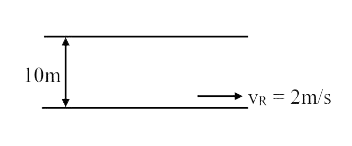A swimmer can swim in still water with a speed of 3 ms−1 While crossing a river his average speed is 5 ms−1 If crosses the river in the shortest possible time, what is the speed of flow of water ?
2ms−1
4ms−1
6ms−1
8ms−1
The correct Answer is:b
To solve the problem, we need to find the speed of the flow of the river based on the swimmer's speed in still water and the average speed while crossing the river.
1. Identify Given Values:
- Speed of the swimmer in still water (V_swimmer) = 3 m/s
- Average speed while crossing the river (V_crossing) = 5 m/s
2. Understand the Relationship:
- When the swimmer crosses the river, his effective speed (V_crossing) is the resultant of his swimming speed and the speed of the river (V_river).
- This can be visualized as a right triangle where:
- One side is the speed of the swimmer in still water (3 m/s).
- The other side is the speed of the river (unknown).
- The hypotenuse is the average speed while crossing (5 m/s).
3. Apply Pythagorean Theorem:
- According to the Pythagorean theorem:
Vcrossing2=Vswimmer2+Vriver2
- Substituting the known values:
52=32+Vriver2
- This simplifies to:
25=9+Vriver2
4. Solve for V_river:
- Rearranging the equation gives:
Vriver2=25−9
Vriver2=16
- Taking the square root of both sides:
Vriver=√16=4 m/s
5. Conclusion:
- The speed of the flow of the river is 4 m/s.
- Speed of the swimmer in still water (V_swimmer) = 3 m/s
- Average speed while crossing the river (V_crossing) = 5 m/s
- When the swimmer crosses the river, his effective speed (V_crossing) is the resultant of his swimming speed and the speed of the river (V_river).
- This can be visualized as a right triangle where:
- One side is the speed of the swimmer in still water (3 m/s).
- The other side is the speed of the river (unknown).
- The hypotenuse is the average speed while crossing (5 m/s).
- According to the Pythagorean theorem:
Vcrossing2=Vswimmer2+Vriver2
- Substituting the known values:
52=32+Vriver2
- This simplifies to:
25=9+Vriver2
- Rearranging the equation gives:
Vriver2=25−9
Vriver2=16
- Taking the square root of both sides:
Vriver=√16=4 m/s
- The speed of the flow of the river is 4 m/s.
Similar Questions
A swimmer can swim in still water with a speed of 2.5 m/s. What is the shortest time taken by him to swim across the river?
 View Solution
View SolutionA man can swim in still water at a speed of 5km/h. Man crosses 1 km width of river along shortest possible path in 15 minutes . What is the speed of river in km/h?
View Solution
Knowledge Check
- Question 1 - Select One
A man can swim in still water with a speed of 2ms−1. If he wants to cross a river of water current speed √3ms−1 along the shortest possible path, then in which direction should he swim ?
AAt an angle 120∘ to the water current.BAt an angle 150∘ to the water current.CAt an angle 90∘ to the water current.DNone of these - Question 2 - Select One
A boy can swim in still water at 1m/s. He swims across a river flowing at 0.6m/s which is 336m wide. If the travels in shortest possible time, then what time he takes to cross the river?
A250sB420sC340sD336s - Question 3 - Select One
A swimmer can swim in still water with speed v and the river is flowing with speed v/2. What is the ratio of the time taken to swimming across the river in shortest time to that of swimming across the river over the shortest distance ?
A√32B1C2D√3v
A person rows a boat in a water with a speed of 4ms−1. Water in the river is flowing with a speed of 2ms−1 . If the person rows the boat perpendiculat to thedirection of flow, find resultant velcity of the boat and time taken by boat to cross the river if widthe of the river is 400m.
View SolutionA man can swim with speed 5ms−1 in still river while the river is also flowing speed 10ms−1 If the width of the river is 100 m then minimum possible drift is
View SolutionA swimmer can swim in still water with speed v and the river is flowing with velociyt v/2. To cross the river in shortest distance, he should swim making angle θ with the upstream. What is the ratio of the time taken to swim across the shortest time to that is swimming across over shortest distance
View SolutionA boatman can row with a speed of 10kmh−1 in still water. River flows at 6kmh−1 . If he crosses the river from one bank to the other along the shortest possible path, time taken to cross that river of width 1 km is
View SolutionA man can swim in still water at a speed of 4kmph. He desires to cross a river flowing at a speed of 3kmph in the shortest time interval. If the width of the river (in hours) and the horizontal distance travelled (in km) are respectively
View Solution

